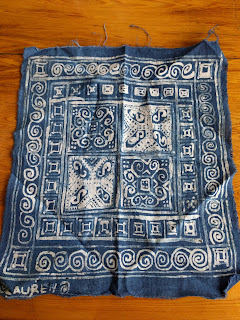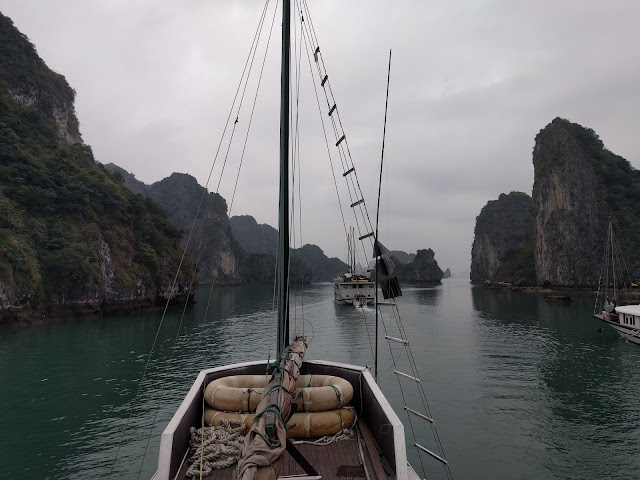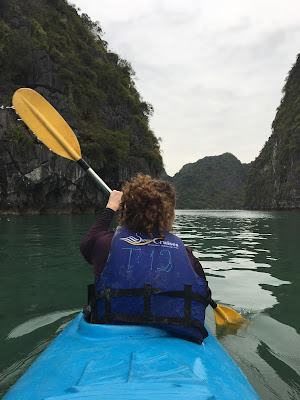I arrived in Hong Kong mid-afternoon, and promptly set out to see the city. Hong Kong is divided into two parts: Hong Kong island, the main part of the city, and Kowloon, the mainland part of the city. A narrow strip of water separates the two, and they are both technically part of Hong Kong. I stayed in Kowloon, and was happy I did so - there is a bit more space and room to breathe, whereas Hong Kong Island is a maze of apartment buildings denser than New York. Hong Kong Island is infinitely better designed than New York to handle such crowds, though, with an aboveground pedestrian walkway system misleadingly called the Escalators (as I sadly learned, the only mechanics involved are with your own two feet). This allows large highways to pass underneath, and the pedestrians walk Hong Kong safely. The walkway is also filled with interesting little factoids, the reading of which caused my journey to double in time.
Below: Hong Kong from above, Mid-Levels Escalators with my favorite factoid, nighttime Hong Kong
True to form, I tried lots of food, my favorite of which was congee, a delicious type of rice porridge that reminds me of grits. This I found in an amazing place called the Food Republic, with food stalls serving food from all over Asia - Thai, Japanese, Taiwanese, etc. It was my own little heaven. I also found my way to a Michelin-started noodle shop/food stall, and paid a grand total of $4 for wonton noodle soup with rather rubbery noodles. Actually, until I saw the signs, I didn't realize the Michelin star was from the same company that manufactures tires, and I'm very curious as to how tire production makes one qualified to judge food. This unexceptional soup experience makes me even more suspicious.
Below: food republic, amazing congee, mediocre noodles
I only had a day and a half, and made the most of all the big sights: taking the sea ferry between Kowloon and Hong Kong, visiting the top of Victoria Peak and taking the tram down, mixing up Jackie Chan and Bruce Lee at the Star Sculpture Garden. I spent some time at the piers in Kowloon, where I was approached by schoolchildren asking about a survey for their school. There were two adorable boys around 8 years old, who asked me which figures I knew best from Hong Kong (I chose Jackie Chan). A few minutes later, a group of 14-year-old schoolboys approached and asked about another survey, this time on the environment, and then told me I was beautiful. Lest I be approached by college students asking me out next, I escaped the area...but then, fulfilling my worst fears, an awkward-looking young man approached and asked I take a picture of him. This I was happy to do, until afterwards he asked to take a picture with me, and as I stammered out an apologetic refusal he put his arm around me and took a selfie with me anyway. Oh, well.
Below: Victoria's Peak (including massive tree), sea ferry, pier selfies
The pier area also contained what I first thought was an exotic hanging garden, but which I soon learned were meticulously maintained public restrooms, complete with the masking sounds of waterfalls and chirping birds piped in. Well done, Hong Kong.
Below: hidden bathroom
My first afternoon in Hong Kong, I made my way over to the Peninsula Hotel for fancy afternoon tea. The Peninsula is the Hong Kong standard in luxury, a colonial-era hotel with beautiful detailing in every corner. Afternoon tea there is a luxury generally enjoyed by the very well off (it costs $40!), but I decided to splurge. My great-aunt Joann enjoyed tea in this very hotel 30 years ago, and I wanted to uphold the tradition.
Well, upholding the tradition turned out to take a bit longer than I anticipated; I spent 45 minutes waiting in line for the privilege. In the end, though, it was worth it - fragrant rose tea, scones, salmon cakes with gold leaf, chocolate mousse. Propriety demanded I leave at least a few crumbs on the plate so I wouldn't look like a huge glutton, but man, was it difficult.
Below: teatime
The Peninsula Hotel also contained the kind of uber-fancy stores one generally associated with the rich and famous: BVLGARI, Cartier, and more. I spent a bit of time wandering around, curious as to what attracts those with too much money on their hands. Some of the designs were appalling: a fortune cookie necklace encrusted with diamonds (really???), a snake head necklace that looked entirely too realistic, rings shaped like panthers. Other items, though, made me realize I may have some very dormant, very expensive tastes - I loved the sparkly diamond necklaces, and even went in a few stores for a closer look. The prices were far more than my life savings, but I kept my cool and told myself that they didn't know I hadn't recently inherited millions from a long-lost uncle or become Hugh Hefner's 20th wife. My poker face worked, and I even got to try some things on in the store!
Below: ugly jewelry x2, nice diamonds
At night, the city turned a bit seedier. Random Indian men stood on the streetcorners; by day they offered me designer watched and purses, but by night they called me baby and told me they loved me. In part to escape them, I wandered into a nearby public park and accidentally found all the drug dealers in Hong Kong. I had decided to explore a corner of the park that was not as well-lit, and around every corner lurked a tall, hunched-over young man who stared at me and then ignored me as I hurried off. Not my wisest decision, but I found my way out of the park unharmed soon enough.
As my last hurrah in Hong Kong, I walked over to a rooftop bar; I ordered a drink, and it came with 4 new friends - 4 Indians working in Hong Kong who took me to get authentic Indian food after we finished our drinks. There were 3 (very nice, respectful) guys, and one girl who tried alcohol for the first time in her 28 years that night. Needless to say, we had a blast; we played all our favorite Bollywood songs, and she taught me how to dance to Bollywood (I can now shake one hip like a pro), and I taught her how to salsa. We are amazing lamb chops, paratha, and biryani, and I went home very happy and very full.
Below: view from rooftop bar
Altogether, Hong Kong seems like a slightly dirtier Singapore, albeit with (dare I say) slightly more culture. I loved it, and I could definitely see myself living here, even with the closet-sized apartments and Kowloon drug dealers. I'm sure my company has an office here...hmm...
Below: Hong Kong from above, Mid-Levels Escalators with my favorite factoid, nighttime Hong Kong
True to form, I tried lots of food, my favorite of which was congee, a delicious type of rice porridge that reminds me of grits. This I found in an amazing place called the Food Republic, with food stalls serving food from all over Asia - Thai, Japanese, Taiwanese, etc. It was my own little heaven. I also found my way to a Michelin-started noodle shop/food stall, and paid a grand total of $4 for wonton noodle soup with rather rubbery noodles. Actually, until I saw the signs, I didn't realize the Michelin star was from the same company that manufactures tires, and I'm very curious as to how tire production makes one qualified to judge food. This unexceptional soup experience makes me even more suspicious.
Below: food republic, amazing congee, mediocre noodles
I only had a day and a half, and made the most of all the big sights: taking the sea ferry between Kowloon and Hong Kong, visiting the top of Victoria Peak and taking the tram down, mixing up Jackie Chan and Bruce Lee at the Star Sculpture Garden. I spent some time at the piers in Kowloon, where I was approached by schoolchildren asking about a survey for their school. There were two adorable boys around 8 years old, who asked me which figures I knew best from Hong Kong (I chose Jackie Chan). A few minutes later, a group of 14-year-old schoolboys approached and asked about another survey, this time on the environment, and then told me I was beautiful. Lest I be approached by college students asking me out next, I escaped the area...but then, fulfilling my worst fears, an awkward-looking young man approached and asked I take a picture of him. This I was happy to do, until afterwards he asked to take a picture with me, and as I stammered out an apologetic refusal he put his arm around me and took a selfie with me anyway. Oh, well.
Below: Victoria's Peak (including massive tree), sea ferry, pier selfies
The pier area also contained what I first thought was an exotic hanging garden, but which I soon learned were meticulously maintained public restrooms, complete with the masking sounds of waterfalls and chirping birds piped in. Well done, Hong Kong.
Below: hidden bathroom
My first afternoon in Hong Kong, I made my way over to the Peninsula Hotel for fancy afternoon tea. The Peninsula is the Hong Kong standard in luxury, a colonial-era hotel with beautiful detailing in every corner. Afternoon tea there is a luxury generally enjoyed by the very well off (it costs $40!), but I decided to splurge. My great-aunt Joann enjoyed tea in this very hotel 30 years ago, and I wanted to uphold the tradition.
Well, upholding the tradition turned out to take a bit longer than I anticipated; I spent 45 minutes waiting in line for the privilege. In the end, though, it was worth it - fragrant rose tea, scones, salmon cakes with gold leaf, chocolate mousse. Propriety demanded I leave at least a few crumbs on the plate so I wouldn't look like a huge glutton, but man, was it difficult.
Below: teatime
The Peninsula Hotel also contained the kind of uber-fancy stores one generally associated with the rich and famous: BVLGARI, Cartier, and more. I spent a bit of time wandering around, curious as to what attracts those with too much money on their hands. Some of the designs were appalling: a fortune cookie necklace encrusted with diamonds (really???), a snake head necklace that looked entirely too realistic, rings shaped like panthers. Other items, though, made me realize I may have some very dormant, very expensive tastes - I loved the sparkly diamond necklaces, and even went in a few stores for a closer look. The prices were far more than my life savings, but I kept my cool and told myself that they didn't know I hadn't recently inherited millions from a long-lost uncle or become Hugh Hefner's 20th wife. My poker face worked, and I even got to try some things on in the store!
Below: ugly jewelry x2, nice diamonds
At night, the city turned a bit seedier. Random Indian men stood on the streetcorners; by day they offered me designer watched and purses, but by night they called me baby and told me they loved me. In part to escape them, I wandered into a nearby public park and accidentally found all the drug dealers in Hong Kong. I had decided to explore a corner of the park that was not as well-lit, and around every corner lurked a tall, hunched-over young man who stared at me and then ignored me as I hurried off. Not my wisest decision, but I found my way out of the park unharmed soon enough.
As my last hurrah in Hong Kong, I walked over to a rooftop bar; I ordered a drink, and it came with 4 new friends - 4 Indians working in Hong Kong who took me to get authentic Indian food after we finished our drinks. There were 3 (very nice, respectful) guys, and one girl who tried alcohol for the first time in her 28 years that night. Needless to say, we had a blast; we played all our favorite Bollywood songs, and she taught me how to dance to Bollywood (I can now shake one hip like a pro), and I taught her how to salsa. We are amazing lamb chops, paratha, and biryani, and I went home very happy and very full.
Below: view from rooftop bar
Altogether, Hong Kong seems like a slightly dirtier Singapore, albeit with (dare I say) slightly more culture. I loved it, and I could definitely see myself living here, even with the closet-sized apartments and Kowloon drug dealers. I'm sure my company has an office here...hmm...










































































